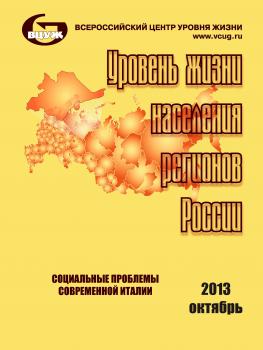Russian Federation
The domestic and international aspects of the socioeconomic inequality in living standards in Russia during the capitalist transformation from 1990 to 2000 are considered. The following indicators of inequality are analyzed: by income spent on consumption, by housing provision, by access to education and healthcare. A comparison of Russia with other countries of the G20 is made. The reasons for high socioeconomic inequality in Russia are revealed. The reachability of parameters of the social structure of the Russian society represented in the Forecast of Long-Term Socioeconomic Development of the Russian Federation for the Period up to the Year 2030 is considered. The conceptual approaches to reducing socioeconomic inequalities are represented.
The Gini index, normative consumer budgets, Russia, socioeconomic inequality, social structure, G20, BRICS.
The time frame is from the end of the Soviet period and the 20th anniversary of capitalist transformations in Russia, as well as the expected period till 2030.
Research Methodology
Inequality will be considered as a diff erentiation of population by living conditions, level and structure of consumption, opportunities to realize individual abilities. Inequality leads to a deprivation of individual rights for dignity and respect.
Socioeconomic inequality manifests itself in consumption inequality, i.e. in inequality in living standards. According to this criterion the following basic forms of social inequality are usually distinguished by: 1) current consumption of material goods and services, 2) housing provision, 3) access to education, 4) access to healthcare, etc.[1]
It seems reasonable to assess the diff erentiation in consumption not by separate products but by complex standards of current consumption. The latter are represented by normative consumer budgets of diff erent income levels. We have applied the following consumer budgets: 1) the offi cial subsistence minimum (SM), 2) the socially acceptable consumer budget, 3) the budget of middle income, and 4) the budget of high income1 [2]. Th ey correspond with each other by size approximately as 1: 3: 7: 11.
A comparison of the actual consumption of the population with these social standards lets us distinguish the following social groups which differ by living standard: those most in need (less than 1 SM); low income (1–3 SM); income less than average (3–7 SM); middle income (7–11 SM), high income (over 11 SM).
Another group that characterizes the living standard includes standards of housing provision also designed by experts of Th e All-Russian Centre of Living Standard: the lowest — 7 sq m, socially acceptable — 18 sq m, average — 30 sq m, and high — 60 and more sq m per person. In addition, these standards include housing quality characteristics which become better as we move from lower to higher housing provision [3]. Characteristics of the social inequality caused by diff erent availability (consumption) of education and healthcare are determined by payment limitations.
_____________
1Standards 2, 3 and 4 have been developed and verified at the All-Russian Centre of Living Standard, Moscow.
1. Gotmakher E. Rossiyskie sotsial’nye neravenstva kak faktor sotsial’no - politicheskoy stabil’nosti [Russian social inequalities as a socio - political stability]. Voprosy ekonomiki [ Problems of Economics]. 2013, no. 4.
2. Bobkov V.N. Sotsial’nye struktury i neravenstvo raspredeleniya naseleniya po kachestvu i urovnyu zhizni [Social structures and population distribution inequality in quality and standard of living]. Moscow, VTsUZh Publ., 2011. 24 p.
3. Bobkova V.N. Kachestvo i uroven’ zhizni naseleniya v sovremennoy Rossii (1991-2005 gg.) [Quality and standard of living in modern Russia (1991-2005 gg.)]. Moscow, VTsUZh Publ., 2007. 719 p.
4. Rossiyskiy statisticheskiy ezhegodnik [Russian Statistical Yearbook]. Moscow, Rosstat Publ., 2011.
5. Uroven’ zhizni naseleniya Rossii [Standard of living of the Russian population]. Moscow, Rosstat Publ., 1996.
6. Sotsial’noe polozhenie i uroven’ zhizni naseleniya Rossii [Social status and standard of living of the Russian population]. Moscow, Rosstat Publ., 2011.
7. Rossiya v tsifrakh 2013. [Russia by the Numbers 2013]. Moscow, Rosstat Publ., 2013.
8. Dokhody, raskhody i potreblenie domashnikh khozyaystv v 2010 godu [Income, expenditure and household consumption in 2010]. Moscow, Rosstat Publ., 2011.
9. Putin V.V. Stroitel’stvo spravedlivosti. Sotsial’naya politika dlya Rossii [Construction of justice. Social policy for Russia]. Komsomol’skaya Pravda [Komsomolskaya Pravda]. 13.02.2013.
10. Rossiyskiy monitoring ekonomicheskogo polozheniya i zdorov’ya naseleniya NIU VShE [Russian Longitudinal Monitoring health Higher School of Economics]. Available at: http://www.hse.ru/org/hse/rlms.
11. Platnoe obsluzhivanie naseleniya v Rossii [Pay service of the Russian population]. Moscow, Rosstat Publ., 2011
12. Abramova E.M., Aleksandrova O.A.,. Kulagina E.V., Loginov D.M. Obrazovatel’nye resursy domokhozyaystv [Educational Resources households]. Moscow, M-Studio Publ., 2008.
13. Kislitsina O. Zdorov’e detey: tendentsii, faktory riska i strategii sberezheniya [Children’s Health: trends, risk factors and strategies for savings]. Moscow, Maks-Press Publ., 2011.
14. Human Development Report, 2011. Published for the UNDP. Moscow,Ves’ Mir Publ.
15. Divided We Stand: Why Inequality Keeps Rising, OECD Publishing, 2011. Available at: http://dx.doi.org/10.1787/9789264119536-en (Accessed 22 June 2013).
16. OECD Data Base. Available at: http://stats.oecd.org/Index.aspx?DataSetCode=IDD (Accessed 19 June 2013).
17. World Bank. World Development Indicators. 2013. Available at: http://data.worldbank.org/indicator (Accessed 19 June 2013).
18. World Economic Outlook Database. 2013. Available at: http://imf.org (Accessed 19 June 2013)
19. Income Distribution, OECD Social and Welfare Statistics. Available at: doi:https://doi.org/10.1787/data-00654-en (Accessed 19 June 2013).
20. The Central Intelligence Agency (CIA). Available at: https://www.cia.gov/index.html (Accessed 23 June 2013).
21. Bobkov V.N. Sistema potrebitel’skikh byudzhetov - osnova nalogooblozheniya semeynykh dokhodov [The System of Consumer Budgets - the Basis of Family Income Taxation], Uroven’ zhizni naselenii regionov Rossii [Level of Life of the Population of Regions of Russia]. 2006, no. 7.
22. EUROSTAT. Available at: http://epp.eu-rostat.ec.europa.eu/portal/page/portal/eurostat/home (Accessed 17 June 2013).
23. Rosstat. Available at: www.gks.ru.
24. Prognoz dolgosrochnogo sotsial’no-ekonomicheskogo razvitiya Rossiyskoy Federatsii na period do 2030 goda [Forecast long-term socio -economic development of the Russian Federation for the period until 2030]. Moscow, 2013.
25. Bobkov V.N. O sotsial’nom izmerenii novogo etapa razvitiya [On the social dimension of the new stage of development], Ekonomist [Economist]. 2013, no. 5.





